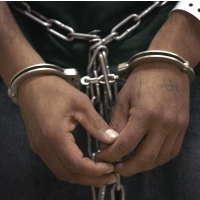Ninth Circuit Tells San Diego Federal Court to Stop Shackling Its Pretrial Detainees
 (photo: Scott Olson via Getty Images)
(photo: Scott Olson via Getty Images)
The U.S. District Court for the Southern District of California can no longer shackle just about all pre-trial prisoners during their court appearances.
The U.S. Ninth Circuit Court of Appeals acknowledged that the financially-strapped U.S. Marshals Office would save money on staffing and logistics by shackling everyone. But the three-judge panel ruled that wasn’t an excuse for denying people their Constitutional rights.
It also looked bad. “The shackles at issue here are also a greater affront to the dignity and decorum of the proceedings, because the shackles themselves are more conspicuous and are used at many different stages of a criminal case,” Judge Mary Schroeder wrote for the court.
The Federal Defenders of San Diego, which represented plaintiffs in the case, agreed. “We felt from the beginning that the process of shackling every client regardless of demonstrated security need is both humiliating and distracts the client from proceedings and diminishes their ability to interact with their lawyers,” Executive Director Reuben Cahn told the San Diego Union-Tribune.
The San Diego court agreed to let the U.S. Marshals use heavy restraints in March 2013 after the agency pleaded poverty and warned of the resulting safety deficiencies. The agency didn’t receive a staffing increase, but still had to service a new, third courthouse that year.
As a result, defendants in most nonjury pretrial proceedings were forced to wear handcuffs and leg shackles that were connected to a 15-inch belly chain. The policy did not apply to instances when a jury was around to avoid prejudicing them.
The San Diego folks argued that the Ninth Circuit seemed down with shackles when it approved the use of heavy restraints at the federal Roybal Courthouse in Los Angeles, but Judge Schroeder wrote the aged, decrepit, converted office building was an obvious exception:
“The government has not demonstrated that the courthouses in the Southern District pose similar problems for security. . . . We therefore hold that a full restraint policy ought to be justified by a commensurate need. It cannot rest primarily on the economic strain of the jailer to provide adequate safeguards.”
In “The Conditions of Pretrial Detention,” a 2013 article by Catherine T. Struve at the University of Pennsylvania, the author notes that the U.S. Supreme Court has addressed the issue of shackling convicted prisoners, but not pretrial detainees. As a result, “The law articulated by the lower courts is unclear and inconsistent, but on the whole shows a trend toward assimilating pretrial detainees’ claims to those of convicted prisoners.”
Slowly, the nation is drifting away from the practice adopted just two years ago in San Diego that the Federal Defenders likened to a “return to the Middle Ages in the Southern District of California.”
–Ken Broder
To Learn More:
9th Circuit Pans Court's Shackling Policy (by Kristina Davis, San Diego Union-Tribune)
Ninth Circuit Cracks Down on Routine Shackling in San Diego Federal Court (by Jamie Ross, Courthouse News Service)
Appeals Court Invalidates Federal Court's Shackling Policy (by Sudhin Thanawala, Associated Press)
United States v. Sanchez Gomez (U.S. Ninth Circuit Court of Appeals)
- Top Stories
- Controversies
- Where is the Money Going?
- California and the Nation
- Appointments and Resignations
- Unusual News
- Latest News
- California Forbids U.S. Immigration Agents from Pretending to be Police
- California Lawmakers Urged to Strip “Self-Dealing” Tax Board of Its Duties
- Big Oil’s Grip on California
- Santa Cruz Police See Homeland Security Betrayal in Use of Gang Roundup as Cover for Immigration Raid
- Oil Companies Face Deadline to Stop Polluting California Groundwater





